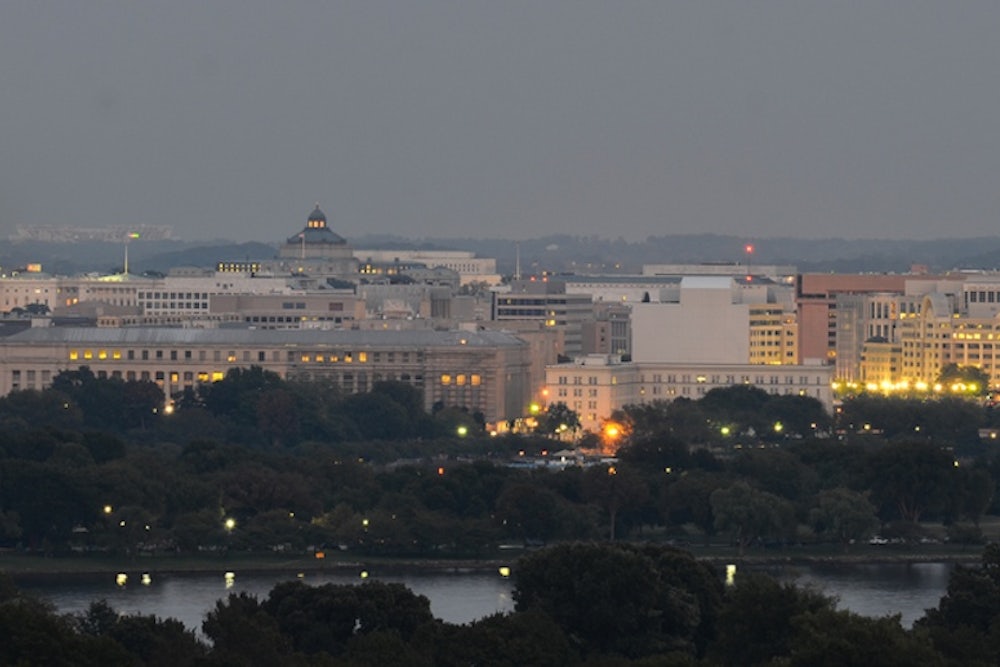Washington, D.C.’s infamous height limit for buildings has returned to the news of late, with the D.C. Office of Planning recommending that current restrictions—which essentially make a 13-story building about as high as you can go—be loosened around D.C.’s core and eliminated altogether elsewhere, with further zoning left to the discretion of the District’s government.
By artificially suppressing housing inventory (the anti-limit argument goes), the law drives up prices, forcing out people who might live or want to live in the District. “The District desperately needs more capacity. The way to build it intelligently is to let the market and the city decide where tall buildings might or might not prove valuable,” Lydia DePillis once wrote at Washington City Paper. “The idea of buildings puncturing D.C.’s squat skyline might seem unsettling at first—especially to those who absorb the terrifying rhetoric from the District’s preservationists. But … abandoning the Height Act and letting zoning rule would be worth it.”
However, since the height limit is encoded in a federal law—the Height of Buildings Act of 1910 (emphasis mine)—Congress would have to change it. Which means Rep. Darrell Issa, the conservative Republican from San Diego who chairs the House Committee on Government and Oversight Reform, would need to be persuaded. And he has seemed, at best, lukewarm.
Might self-interest succeed in pushing him and national Republicans where common sense and empathy have failed? Might they be inclined to ease the height limit, paving the way for skyscrapers in Tenleytown and on H Street, if doing so could help them politically? Specifically, by turning Virginia red again?
According to Christopher Leinberger, a Brookings Institute fellow and author of The Option of Urbanism, the height limit’s persistence could cause D.C. to lose market share to the nearby suburbs in Maryland and Virginia, something which has not happened for nearly a decade as improved schools, safer streets, and the desirability of walkable urban neighborhoods have made D.C. a more attractive place to live. The District has “not felt the impact of height limits on supply” yet, Leinberger argued. However, he added, “we will be feeling that impact in the future. In greater downtown D.C., we probably have 15 or 20 years of supply left as far as potential build-out. From a real estate perspective, 15 to 20 years begins to influence prices now.”
The height limit, he predicted, “will begin to impact [suburban population growth] if in fact D.C. is stupid enough to lose their ability to gain market share.”
From here it is not much of a leap to guess that the height limit, which may already have driven some poorer residents out of D.C., will eventually drive precisely the sort of people who otherwise would want to live in the most obvious urban, walkable neighborhoods—which are in and on the periphery of L’Enfant’s original city—to the suburbs, particularly in Virginia, where there are already several urban-type neighborhoods. And such moderate young professionals are the very people who have contributed to one of the most striking stories in national politics today: The slow but sure turn of Virginia, with its two Senate seats and 13 electoral votes, from a red to a blue state.
The commonwealth that once housed the capital of the Confederacy and that, before Barack Obama, had not gone for the Democratic presidential candidate since 1964 is now solidly trending blue. Obama won it in the last two elections. The Democrat won the last three Senate elections. And last week, Terry McAuliffe—a onetime Democratic Party chair—was elected to the Executive Mansion in Richmond. There are a number of important and big reasons for this, including the black and women votes. But perhaps most importantly, northern Virginia’s booming, knowledge-based economy—driven by a mini Silicon Valley originally anchored around AOL’s former headquarters in Dulles, Virginia; biomedical research; and, of course, two big wars—has led to disproportionate population growth peopled by disproportionately upwardly mobile, highly educated, racially diverse, blue-leaning people.
“They’re educated,” said George Mason University professor Toni-Michelle C. Travis. “And because they’re younger and maybe grew up in a more diverse world, they’re more for equality, trying to close some of these horrendous gaps between the haves and the have-nots. They tend to be Democratic—at least until they own the business!”
D.C. has already probably effectively lost residents to the ‘burbs. Maryland’s Montgomery County and northern Virginia both provide superior schools and, more recently, dense, walkable communities.
And the rise of these so-called “urban suburbs” has had quantifiable political implications in Virginia. (Maryland, which has the fourth-highest percentage of African-Americans of any state, has long been solidly blue.) Northern Virginia—Arlington and Alexandria; and Fairfax, Loudon, and Prince William Counties, essentially, which are all near Washington, D.C.—has experienced population growth well above the commonwealth’s, and contributed a still-more outsize share of McAuliffe’s coalition. The soon-to-open Silver Line of the D.C. Metro will only accelerate this process in Fairfax County. “Tysons is going to be a city,” Davis stated flatly.
The thing is, that will likely be true even if Congress does remove the height limit. According to Davis and Leinberger, northern Virginia will continue to gain population. “When I look at the pent-up demand for walkable urban places,” Leinberger said, “there’s enough for both.” Lifting the height limit, he continued, “may sap [growth in northern Virginia] a little bit, but I think northern Virginia is going to become more blue and continue to grow. That's demographically in the cards.”
So the argument for self-interest is a hard sell after all. All that’s left is common sense.
Image via Shutterstock.
